A Research Proposal on Customer Satisfaction in the Hotel Sector
VerifiedAdded on 2023/06/11
|12
|2128
|52
Report
AI Summary
This research proposal outlines a study on customer satisfaction in the Australian hotel industry, focusing on Hilton Hotel. It addresses the problem of increasing competition and the need for hotels to maintain customer loyalty. The research objectives include understanding the contribution of customer satisfaction to loyalty, identifying tourist demands, and investigating Hilton Hotel's strategies for meeting customer needs. The proposal details a deductive research design, primary data collection using a Qualtrics survey, random probability sampling, and quantitative data analysis techniques. Ethical considerations such as data confidentiality and informed consent are also addressed. This report explores the methods and techniques used by hotels to ensure customer satisfaction, with a focus on sustaining in a competitive market through positive brand image and customer loyalty.
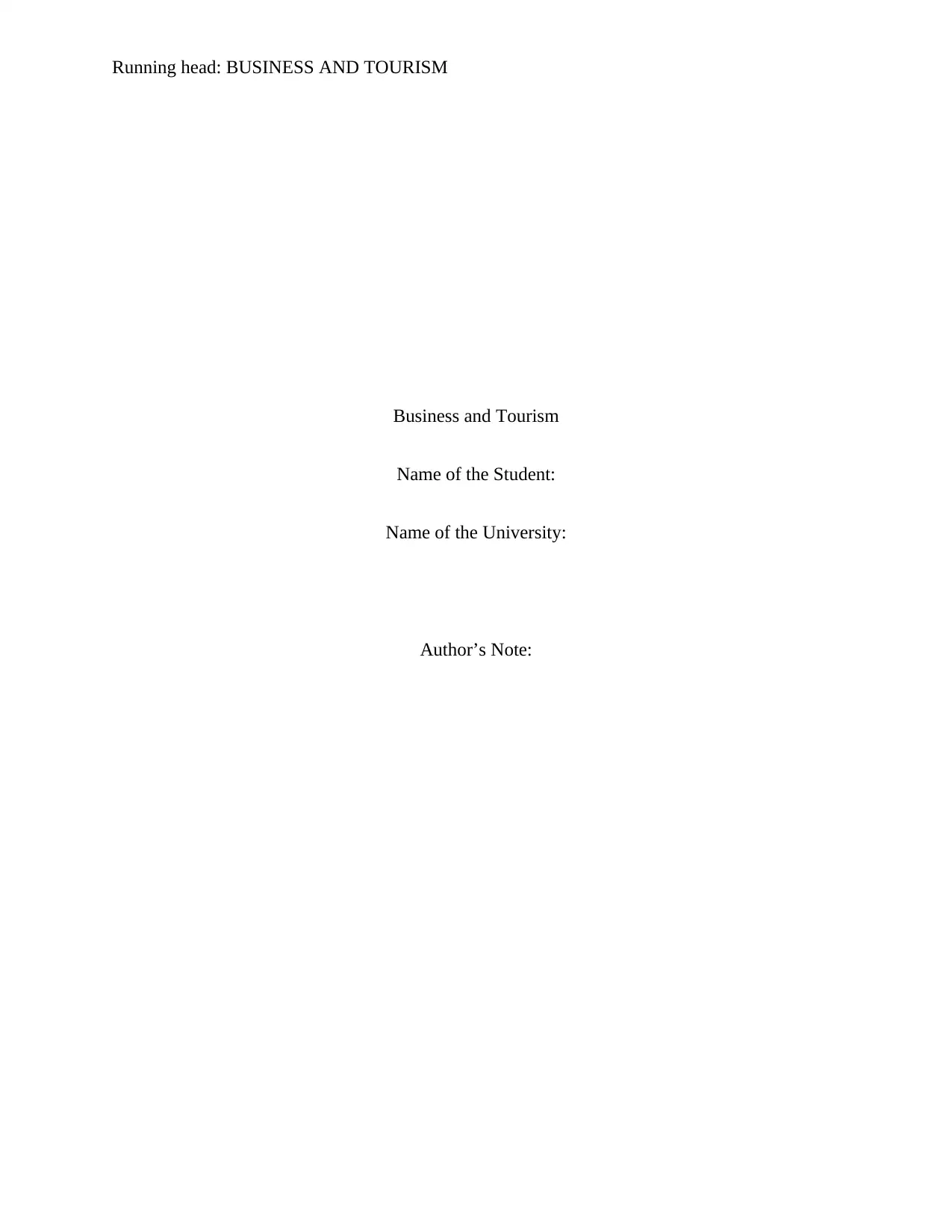
Running head: BUSINESS AND TOURISM
Business and Tourism
Name of the Student:
Name of the University:
Author’s Note:
Business and Tourism
Name of the Student:
Name of the University:
Author’s Note:
Paraphrase This Document
Need a fresh take? Get an instant paraphrase of this document with our AI Paraphraser
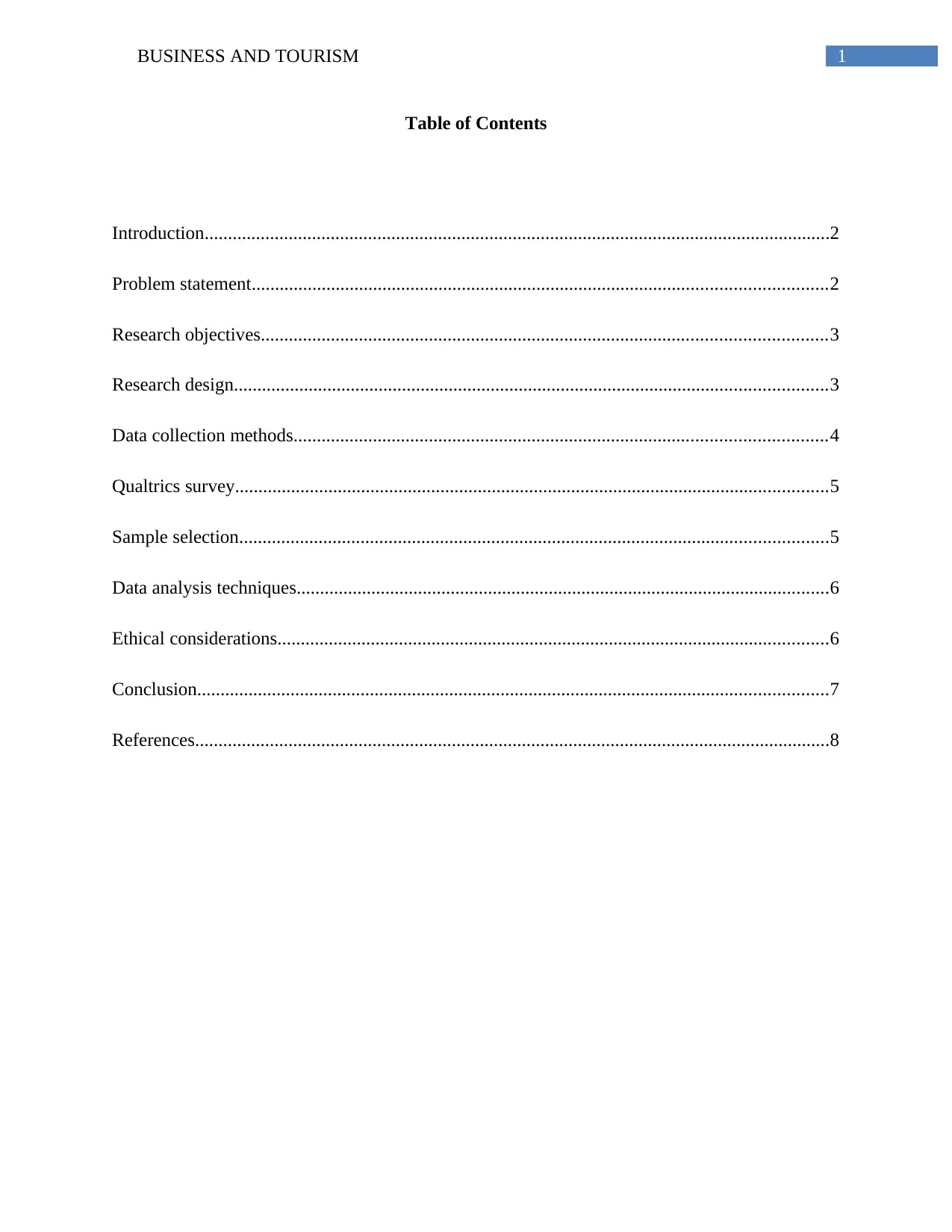
1BUSINESS AND TOURISM
Table of Contents
Introduction......................................................................................................................................2
Problem statement...........................................................................................................................2
Research objectives.........................................................................................................................3
Research design...............................................................................................................................3
Data collection methods..................................................................................................................4
Qualtrics survey...............................................................................................................................5
Sample selection..............................................................................................................................5
Data analysis techniques..................................................................................................................6
Ethical considerations......................................................................................................................6
Conclusion.......................................................................................................................................7
References........................................................................................................................................8
Table of Contents
Introduction......................................................................................................................................2
Problem statement...........................................................................................................................2
Research objectives.........................................................................................................................3
Research design...............................................................................................................................3
Data collection methods..................................................................................................................4
Qualtrics survey...............................................................................................................................5
Sample selection..............................................................................................................................5
Data analysis techniques..................................................................................................................6
Ethical considerations......................................................................................................................6
Conclusion.......................................................................................................................................7
References........................................................................................................................................8
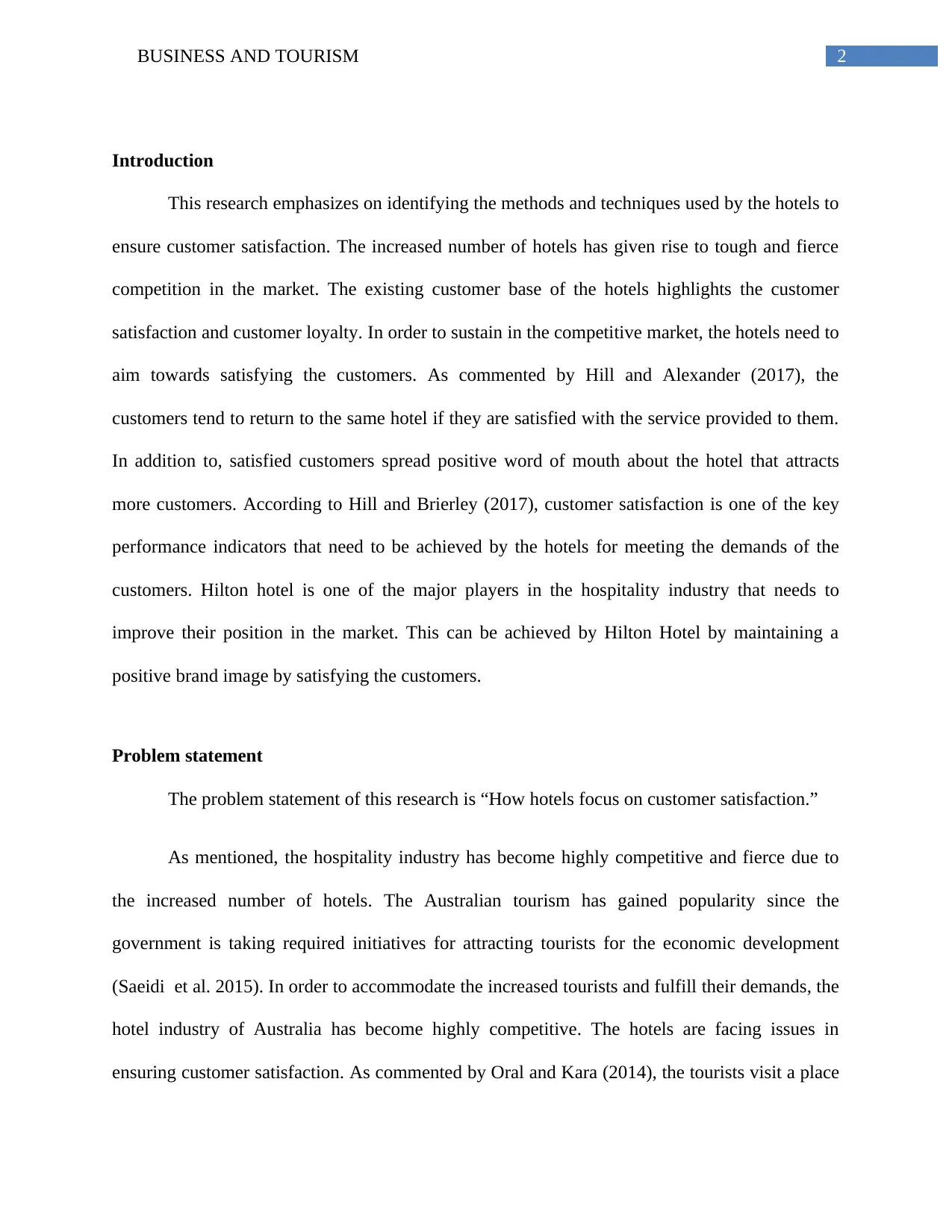
2BUSINESS AND TOURISM
Introduction
This research emphasizes on identifying the methods and techniques used by the hotels to
ensure customer satisfaction. The increased number of hotels has given rise to tough and fierce
competition in the market. The existing customer base of the hotels highlights the customer
satisfaction and customer loyalty. In order to sustain in the competitive market, the hotels need to
aim towards satisfying the customers. As commented by Hill and Alexander (2017), the
customers tend to return to the same hotel if they are satisfied with the service provided to them.
In addition to, satisfied customers spread positive word of mouth about the hotel that attracts
more customers. According to Hill and Brierley (2017), customer satisfaction is one of the key
performance indicators that need to be achieved by the hotels for meeting the demands of the
customers. Hilton hotel is one of the major players in the hospitality industry that needs to
improve their position in the market. This can be achieved by Hilton Hotel by maintaining a
positive brand image by satisfying the customers.
Problem statement
The problem statement of this research is “How hotels focus on customer satisfaction.”
As mentioned, the hospitality industry has become highly competitive and fierce due to
the increased number of hotels. The Australian tourism has gained popularity since the
government is taking required initiatives for attracting tourists for the economic development
(Saeidi et al. 2015). In order to accommodate the increased tourists and fulfill their demands, the
hotel industry of Australia has become highly competitive. The hotels are facing issues in
ensuring customer satisfaction. As commented by Oral and Kara (2014), the tourists visit a place
Introduction
This research emphasizes on identifying the methods and techniques used by the hotels to
ensure customer satisfaction. The increased number of hotels has given rise to tough and fierce
competition in the market. The existing customer base of the hotels highlights the customer
satisfaction and customer loyalty. In order to sustain in the competitive market, the hotels need to
aim towards satisfying the customers. As commented by Hill and Alexander (2017), the
customers tend to return to the same hotel if they are satisfied with the service provided to them.
In addition to, satisfied customers spread positive word of mouth about the hotel that attracts
more customers. According to Hill and Brierley (2017), customer satisfaction is one of the key
performance indicators that need to be achieved by the hotels for meeting the demands of the
customers. Hilton hotel is one of the major players in the hospitality industry that needs to
improve their position in the market. This can be achieved by Hilton Hotel by maintaining a
positive brand image by satisfying the customers.
Problem statement
The problem statement of this research is “How hotels focus on customer satisfaction.”
As mentioned, the hospitality industry has become highly competitive and fierce due to
the increased number of hotels. The Australian tourism has gained popularity since the
government is taking required initiatives for attracting tourists for the economic development
(Saeidi et al. 2015). In order to accommodate the increased tourists and fulfill their demands, the
hotel industry of Australia has become highly competitive. The hotels are facing issues in
ensuring customer satisfaction. As commented by Oral and Kara (2014), the tourists visit a place
⊘ This is a preview!⊘
Do you want full access?
Subscribe today to unlock all pages.

Trusted by 1+ million students worldwide
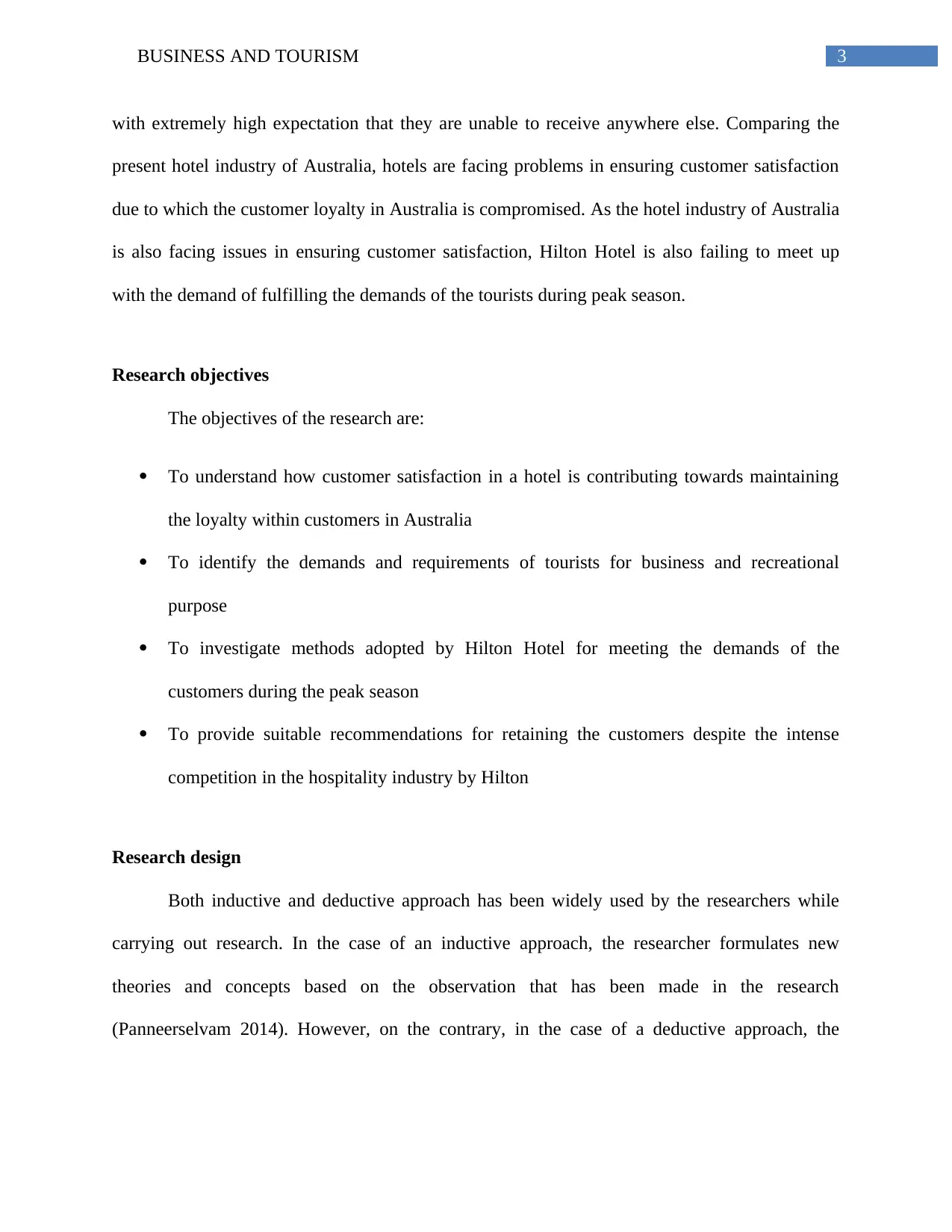
3BUSINESS AND TOURISM
with extremely high expectation that they are unable to receive anywhere else. Comparing the
present hotel industry of Australia, hotels are facing problems in ensuring customer satisfaction
due to which the customer loyalty in Australia is compromised. As the hotel industry of Australia
is also facing issues in ensuring customer satisfaction, Hilton Hotel is also failing to meet up
with the demand of fulfilling the demands of the tourists during peak season.
Research objectives
The objectives of the research are:
To understand how customer satisfaction in a hotel is contributing towards maintaining
the loyalty within customers in Australia
To identify the demands and requirements of tourists for business and recreational
purpose
To investigate methods adopted by Hilton Hotel for meeting the demands of the
customers during the peak season
To provide suitable recommendations for retaining the customers despite the intense
competition in the hospitality industry by Hilton
Research design
Both inductive and deductive approach has been widely used by the researchers while
carrying out research. In the case of an inductive approach, the researcher formulates new
theories and concepts based on the observation that has been made in the research
(Panneerselvam 2014). However, on the contrary, in the case of a deductive approach, the
with extremely high expectation that they are unable to receive anywhere else. Comparing the
present hotel industry of Australia, hotels are facing problems in ensuring customer satisfaction
due to which the customer loyalty in Australia is compromised. As the hotel industry of Australia
is also facing issues in ensuring customer satisfaction, Hilton Hotel is also failing to meet up
with the demand of fulfilling the demands of the tourists during peak season.
Research objectives
The objectives of the research are:
To understand how customer satisfaction in a hotel is contributing towards maintaining
the loyalty within customers in Australia
To identify the demands and requirements of tourists for business and recreational
purpose
To investigate methods adopted by Hilton Hotel for meeting the demands of the
customers during the peak season
To provide suitable recommendations for retaining the customers despite the intense
competition in the hospitality industry by Hilton
Research design
Both inductive and deductive approach has been widely used by the researchers while
carrying out research. In the case of an inductive approach, the researcher formulates new
theories and concepts based on the observation that has been made in the research
(Panneerselvam 2014). However, on the contrary, in the case of a deductive approach, the
Paraphrase This Document
Need a fresh take? Get an instant paraphrase of this document with our AI Paraphraser
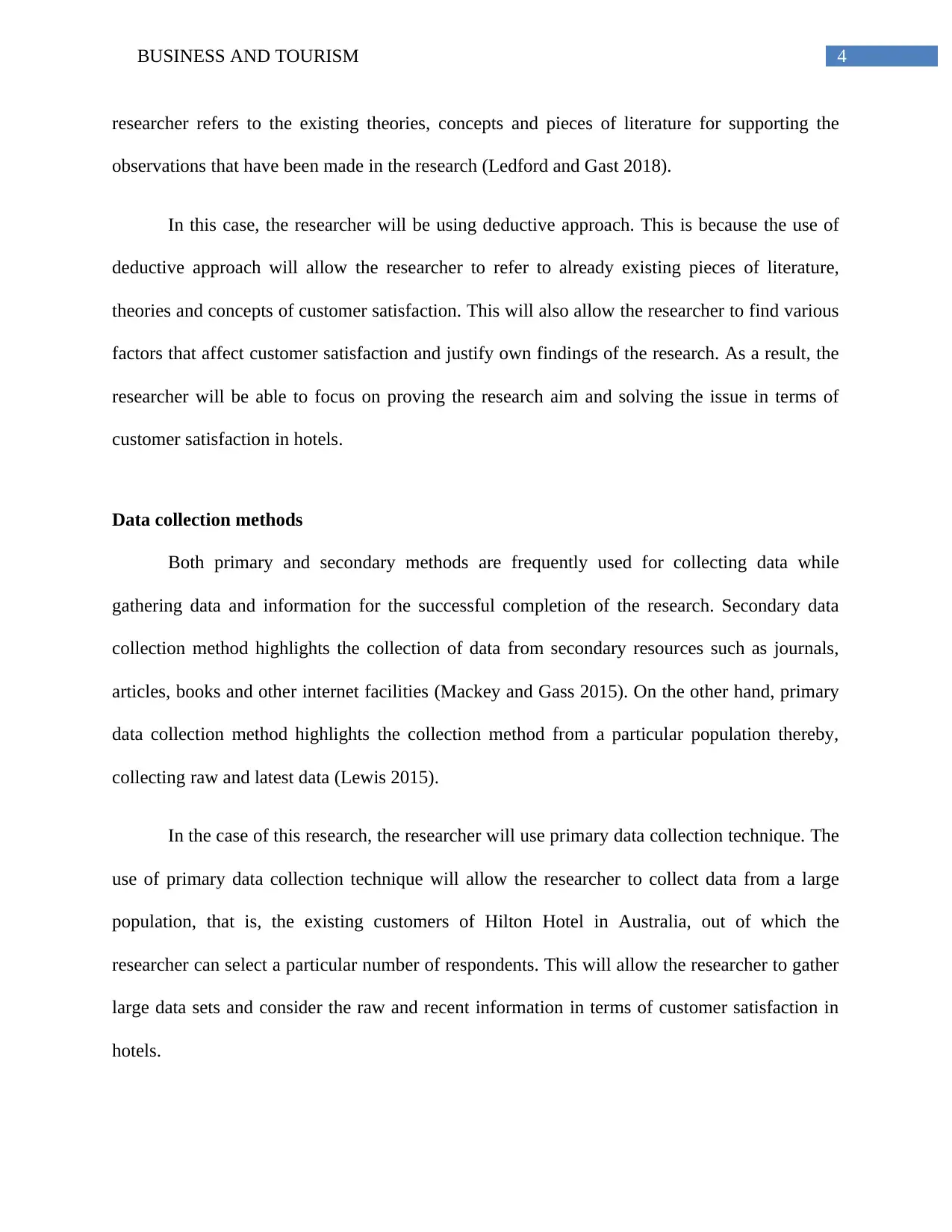
4BUSINESS AND TOURISM
researcher refers to the existing theories, concepts and pieces of literature for supporting the
observations that have been made in the research (Ledford and Gast 2018).
In this case, the researcher will be using deductive approach. This is because the use of
deductive approach will allow the researcher to refer to already existing pieces of literature,
theories and concepts of customer satisfaction. This will also allow the researcher to find various
factors that affect customer satisfaction and justify own findings of the research. As a result, the
researcher will be able to focus on proving the research aim and solving the issue in terms of
customer satisfaction in hotels.
Data collection methods
Both primary and secondary methods are frequently used for collecting data while
gathering data and information for the successful completion of the research. Secondary data
collection method highlights the collection of data from secondary resources such as journals,
articles, books and other internet facilities (Mackey and Gass 2015). On the other hand, primary
data collection method highlights the collection method from a particular population thereby,
collecting raw and latest data (Lewis 2015).
In the case of this research, the researcher will use primary data collection technique. The
use of primary data collection technique will allow the researcher to collect data from a large
population, that is, the existing customers of Hilton Hotel in Australia, out of which the
researcher can select a particular number of respondents. This will allow the researcher to gather
large data sets and consider the raw and recent information in terms of customer satisfaction in
hotels.
researcher refers to the existing theories, concepts and pieces of literature for supporting the
observations that have been made in the research (Ledford and Gast 2018).
In this case, the researcher will be using deductive approach. This is because the use of
deductive approach will allow the researcher to refer to already existing pieces of literature,
theories and concepts of customer satisfaction. This will also allow the researcher to find various
factors that affect customer satisfaction and justify own findings of the research. As a result, the
researcher will be able to focus on proving the research aim and solving the issue in terms of
customer satisfaction in hotels.
Data collection methods
Both primary and secondary methods are frequently used for collecting data while
gathering data and information for the successful completion of the research. Secondary data
collection method highlights the collection of data from secondary resources such as journals,
articles, books and other internet facilities (Mackey and Gass 2015). On the other hand, primary
data collection method highlights the collection method from a particular population thereby,
collecting raw and latest data (Lewis 2015).
In the case of this research, the researcher will use primary data collection technique. The
use of primary data collection technique will allow the researcher to collect data from a large
population, that is, the existing customers of Hilton Hotel in Australia, out of which the
researcher can select a particular number of respondents. This will allow the researcher to gather
large data sets and consider the raw and recent information in terms of customer satisfaction in
hotels.
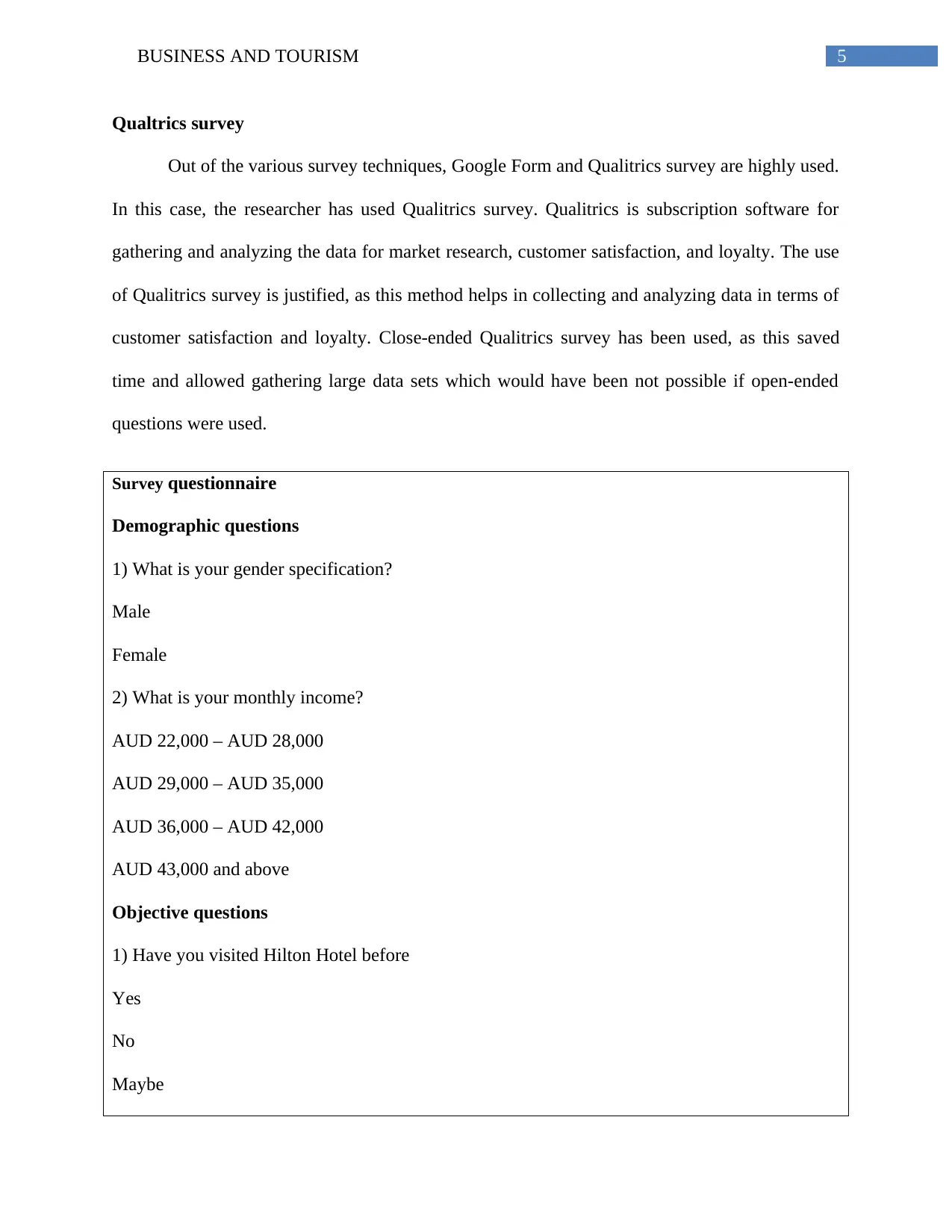
5BUSINESS AND TOURISM
Qualtrics survey
Out of the various survey techniques, Google Form and Qualitrics survey are highly used.
In this case, the researcher has used Qualitrics survey. Qualitrics is subscription software for
gathering and analyzing the data for market research, customer satisfaction, and loyalty. The use
of Qualitrics survey is justified, as this method helps in collecting and analyzing data in terms of
customer satisfaction and loyalty. Close-ended Qualitrics survey has been used, as this saved
time and allowed gathering large data sets which would have been not possible if open-ended
questions were used.
Survey questionnaire
Demographic questions
1) What is your gender specification?
Male
Female
2) What is your monthly income?
AUD 22,000 – AUD 28,000
AUD 29,000 – AUD 35,000
AUD 36,000 – AUD 42,000
AUD 43,000 and above
Objective questions
1) Have you visited Hilton Hotel before
Yes
No
Maybe
Qualtrics survey
Out of the various survey techniques, Google Form and Qualitrics survey are highly used.
In this case, the researcher has used Qualitrics survey. Qualitrics is subscription software for
gathering and analyzing the data for market research, customer satisfaction, and loyalty. The use
of Qualitrics survey is justified, as this method helps in collecting and analyzing data in terms of
customer satisfaction and loyalty. Close-ended Qualitrics survey has been used, as this saved
time and allowed gathering large data sets which would have been not possible if open-ended
questions were used.
Survey questionnaire
Demographic questions
1) What is your gender specification?
Male
Female
2) What is your monthly income?
AUD 22,000 – AUD 28,000
AUD 29,000 – AUD 35,000
AUD 36,000 – AUD 42,000
AUD 43,000 and above
Objective questions
1) Have you visited Hilton Hotel before
Yes
No
Maybe
⊘ This is a preview!⊘
Do you want full access?
Subscribe today to unlock all pages.

Trusted by 1+ million students worldwide
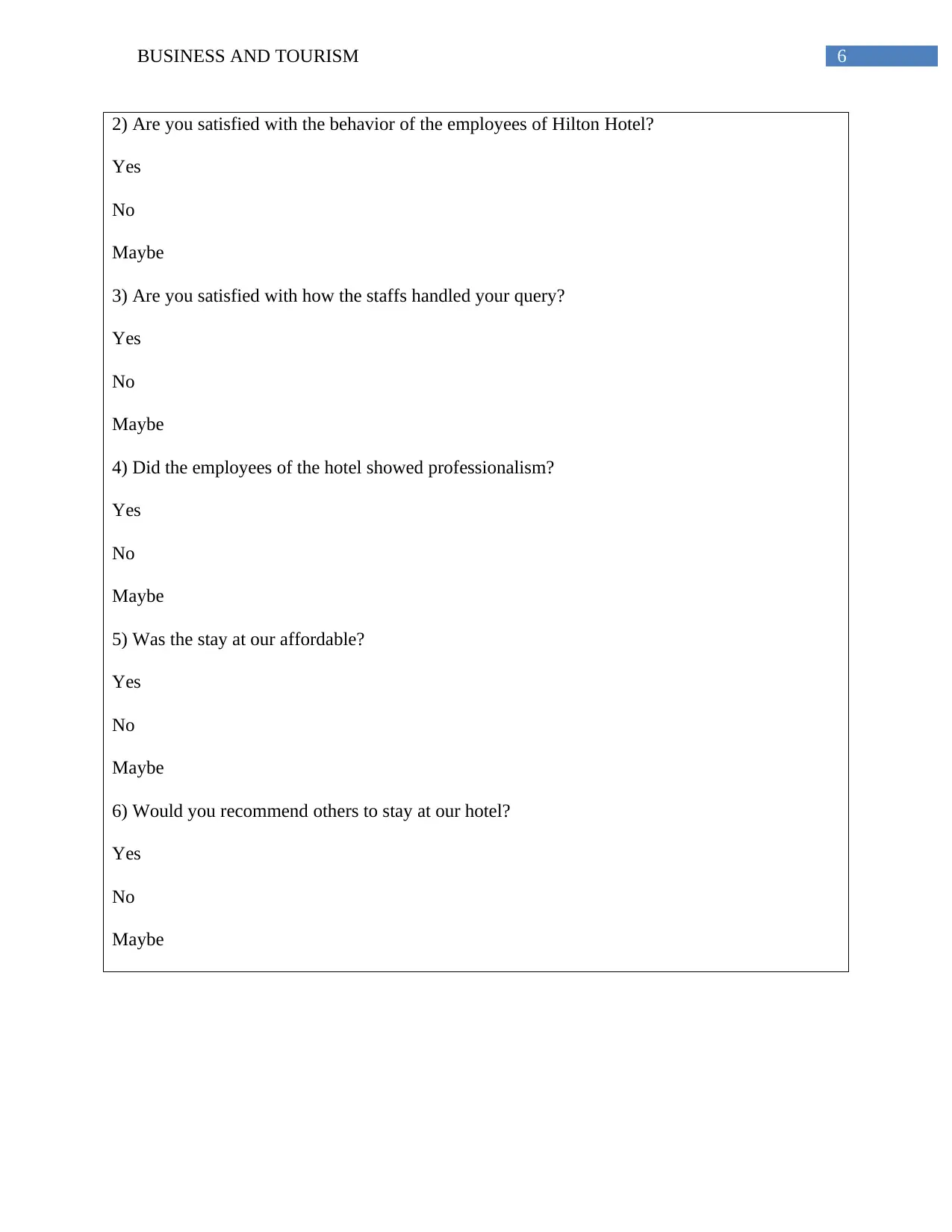
6BUSINESS AND TOURISM
2) Are you satisfied with the behavior of the employees of Hilton Hotel?
Yes
No
Maybe
3) Are you satisfied with how the staffs handled your query?
Yes
No
Maybe
4) Did the employees of the hotel showed professionalism?
Yes
No
Maybe
5) Was the stay at our affordable?
Yes
No
Maybe
6) Would you recommend others to stay at our hotel?
Yes
No
Maybe
2) Are you satisfied with the behavior of the employees of Hilton Hotel?
Yes
No
Maybe
3) Are you satisfied with how the staffs handled your query?
Yes
No
Maybe
4) Did the employees of the hotel showed professionalism?
Yes
No
Maybe
5) Was the stay at our affordable?
Yes
No
Maybe
6) Would you recommend others to stay at our hotel?
Yes
No
Maybe
Paraphrase This Document
Need a fresh take? Get an instant paraphrase of this document with our AI Paraphraser
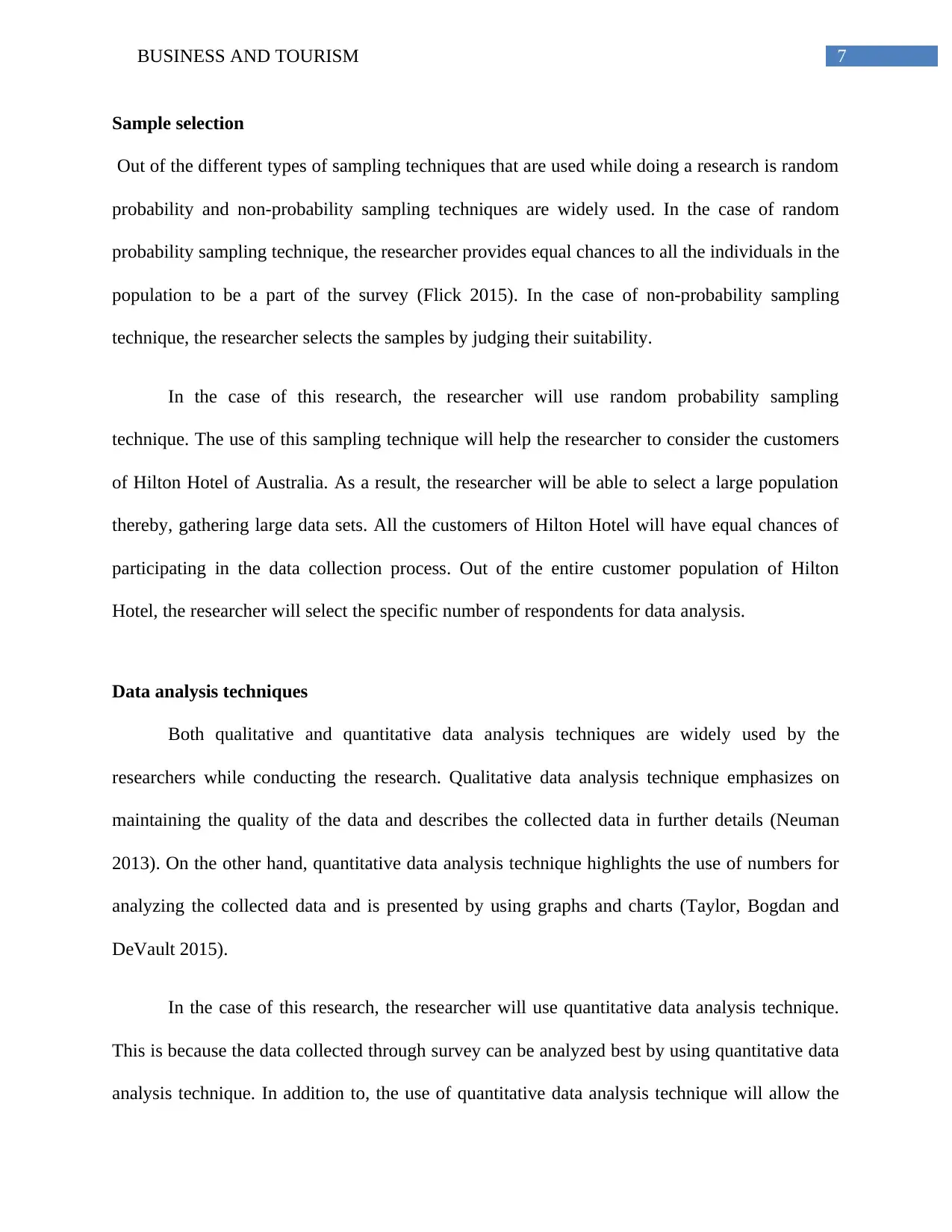
7BUSINESS AND TOURISM
Sample selection
Out of the different types of sampling techniques that are used while doing a research is random
probability and non-probability sampling techniques are widely used. In the case of random
probability sampling technique, the researcher provides equal chances to all the individuals in the
population to be a part of the survey (Flick 2015). In the case of non-probability sampling
technique, the researcher selects the samples by judging their suitability.
In the case of this research, the researcher will use random probability sampling
technique. The use of this sampling technique will help the researcher to consider the customers
of Hilton Hotel of Australia. As a result, the researcher will be able to select a large population
thereby, gathering large data sets. All the customers of Hilton Hotel will have equal chances of
participating in the data collection process. Out of the entire customer population of Hilton
Hotel, the researcher will select the specific number of respondents for data analysis.
Data analysis techniques
Both qualitative and quantitative data analysis techniques are widely used by the
researchers while conducting the research. Qualitative data analysis technique emphasizes on
maintaining the quality of the data and describes the collected data in further details (Neuman
2013). On the other hand, quantitative data analysis technique highlights the use of numbers for
analyzing the collected data and is presented by using graphs and charts (Taylor, Bogdan and
DeVault 2015).
In the case of this research, the researcher will use quantitative data analysis technique.
This is because the data collected through survey can be analyzed best by using quantitative data
analysis technique. In addition to, the use of quantitative data analysis technique will allow the
Sample selection
Out of the different types of sampling techniques that are used while doing a research is random
probability and non-probability sampling techniques are widely used. In the case of random
probability sampling technique, the researcher provides equal chances to all the individuals in the
population to be a part of the survey (Flick 2015). In the case of non-probability sampling
technique, the researcher selects the samples by judging their suitability.
In the case of this research, the researcher will use random probability sampling
technique. The use of this sampling technique will help the researcher to consider the customers
of Hilton Hotel of Australia. As a result, the researcher will be able to select a large population
thereby, gathering large data sets. All the customers of Hilton Hotel will have equal chances of
participating in the data collection process. Out of the entire customer population of Hilton
Hotel, the researcher will select the specific number of respondents for data analysis.
Data analysis techniques
Both qualitative and quantitative data analysis techniques are widely used by the
researchers while conducting the research. Qualitative data analysis technique emphasizes on
maintaining the quality of the data and describes the collected data in further details (Neuman
2013). On the other hand, quantitative data analysis technique highlights the use of numbers for
analyzing the collected data and is presented by using graphs and charts (Taylor, Bogdan and
DeVault 2015).
In the case of this research, the researcher will use quantitative data analysis technique.
This is because the data collected through survey can be analyzed best by using quantitative data
analysis technique. In addition to, the use of quantitative data analysis technique will allow the
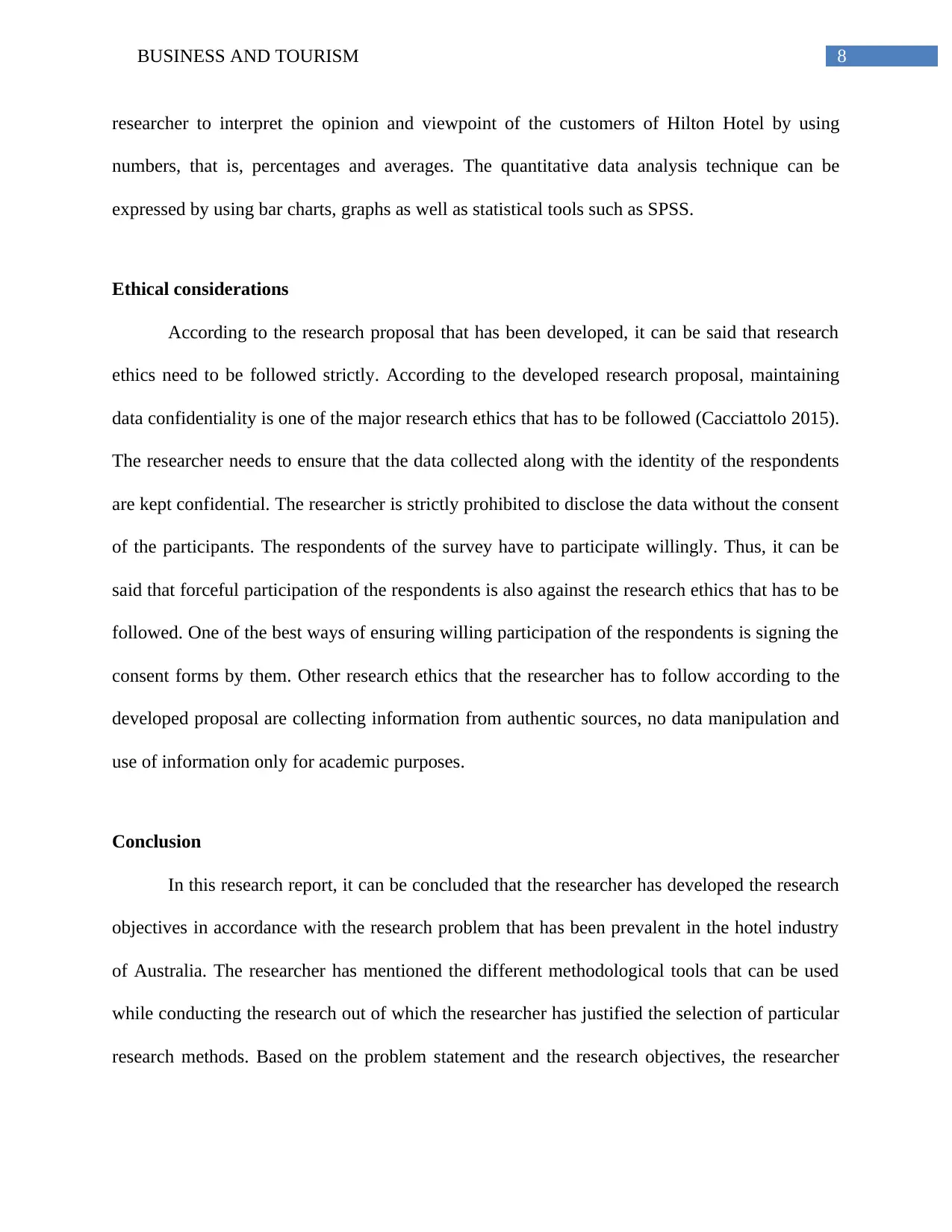
8BUSINESS AND TOURISM
researcher to interpret the opinion and viewpoint of the customers of Hilton Hotel by using
numbers, that is, percentages and averages. The quantitative data analysis technique can be
expressed by using bar charts, graphs as well as statistical tools such as SPSS.
Ethical considerations
According to the research proposal that has been developed, it can be said that research
ethics need to be followed strictly. According to the developed research proposal, maintaining
data confidentiality is one of the major research ethics that has to be followed (Cacciattolo 2015).
The researcher needs to ensure that the data collected along with the identity of the respondents
are kept confidential. The researcher is strictly prohibited to disclose the data without the consent
of the participants. The respondents of the survey have to participate willingly. Thus, it can be
said that forceful participation of the respondents is also against the research ethics that has to be
followed. One of the best ways of ensuring willing participation of the respondents is signing the
consent forms by them. Other research ethics that the researcher has to follow according to the
developed proposal are collecting information from authentic sources, no data manipulation and
use of information only for academic purposes.
Conclusion
In this research report, it can be concluded that the researcher has developed the research
objectives in accordance with the research problem that has been prevalent in the hotel industry
of Australia. The researcher has mentioned the different methodological tools that can be used
while conducting the research out of which the researcher has justified the selection of particular
research methods. Based on the problem statement and the research objectives, the researcher
researcher to interpret the opinion and viewpoint of the customers of Hilton Hotel by using
numbers, that is, percentages and averages. The quantitative data analysis technique can be
expressed by using bar charts, graphs as well as statistical tools such as SPSS.
Ethical considerations
According to the research proposal that has been developed, it can be said that research
ethics need to be followed strictly. According to the developed research proposal, maintaining
data confidentiality is one of the major research ethics that has to be followed (Cacciattolo 2015).
The researcher needs to ensure that the data collected along with the identity of the respondents
are kept confidential. The researcher is strictly prohibited to disclose the data without the consent
of the participants. The respondents of the survey have to participate willingly. Thus, it can be
said that forceful participation of the respondents is also against the research ethics that has to be
followed. One of the best ways of ensuring willing participation of the respondents is signing the
consent forms by them. Other research ethics that the researcher has to follow according to the
developed proposal are collecting information from authentic sources, no data manipulation and
use of information only for academic purposes.
Conclusion
In this research report, it can be concluded that the researcher has developed the research
objectives in accordance with the research problem that has been prevalent in the hotel industry
of Australia. The researcher has mentioned the different methodological tools that can be used
while conducting the research out of which the researcher has justified the selection of particular
research methods. Based on the problem statement and the research objectives, the researcher
⊘ This is a preview!⊘
Do you want full access?
Subscribe today to unlock all pages.

Trusted by 1+ million students worldwide

9BUSINESS AND TOURISM
has selected particular research designs, data collection methods, Qualtrics survey, sample
selection, data analysis techniques and the ethical considerations.
has selected particular research designs, data collection methods, Qualtrics survey, sample
selection, data analysis techniques and the ethical considerations.
Paraphrase This Document
Need a fresh take? Get an instant paraphrase of this document with our AI Paraphraser
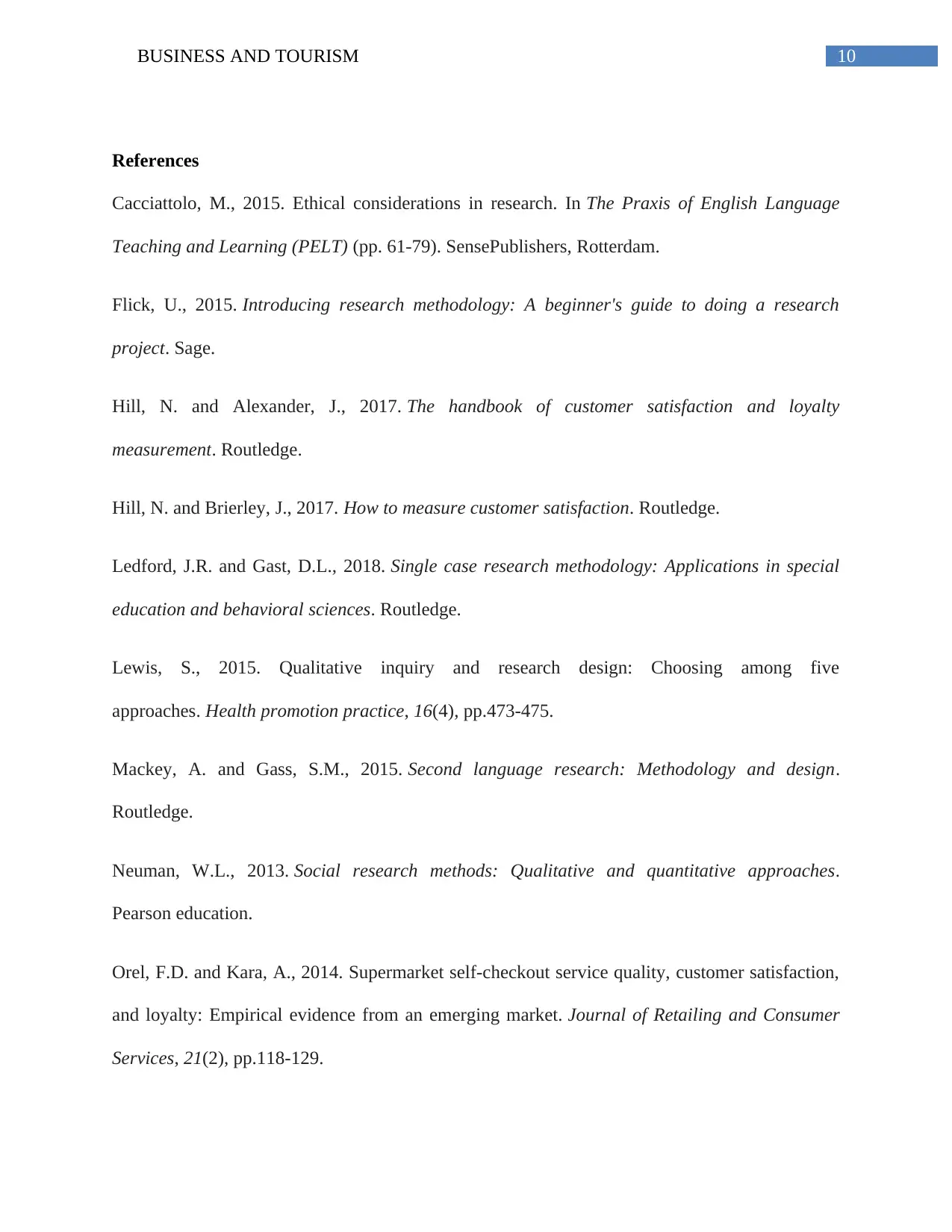
10BUSINESS AND TOURISM
References
Cacciattolo, M., 2015. Ethical considerations in research. In The Praxis of English Language
Teaching and Learning (PELT) (pp. 61-79). SensePublishers, Rotterdam.
Flick, U., 2015. Introducing research methodology: A beginner's guide to doing a research
project. Sage.
Hill, N. and Alexander, J., 2017. The handbook of customer satisfaction and loyalty
measurement. Routledge.
Hill, N. and Brierley, J., 2017. How to measure customer satisfaction. Routledge.
Ledford, J.R. and Gast, D.L., 2018. Single case research methodology: Applications in special
education and behavioral sciences. Routledge.
Lewis, S., 2015. Qualitative inquiry and research design: Choosing among five
approaches. Health promotion practice, 16(4), pp.473-475.
Mackey, A. and Gass, S.M., 2015. Second language research: Methodology and design.
Routledge.
Neuman, W.L., 2013. Social research methods: Qualitative and quantitative approaches.
Pearson education.
Orel, F.D. and Kara, A., 2014. Supermarket self-checkout service quality, customer satisfaction,
and loyalty: Empirical evidence from an emerging market. Journal of Retailing and Consumer
Services, 21(2), pp.118-129.
References
Cacciattolo, M., 2015. Ethical considerations in research. In The Praxis of English Language
Teaching and Learning (PELT) (pp. 61-79). SensePublishers, Rotterdam.
Flick, U., 2015. Introducing research methodology: A beginner's guide to doing a research
project. Sage.
Hill, N. and Alexander, J., 2017. The handbook of customer satisfaction and loyalty
measurement. Routledge.
Hill, N. and Brierley, J., 2017. How to measure customer satisfaction. Routledge.
Ledford, J.R. and Gast, D.L., 2018. Single case research methodology: Applications in special
education and behavioral sciences. Routledge.
Lewis, S., 2015. Qualitative inquiry and research design: Choosing among five
approaches. Health promotion practice, 16(4), pp.473-475.
Mackey, A. and Gass, S.M., 2015. Second language research: Methodology and design.
Routledge.
Neuman, W.L., 2013. Social research methods: Qualitative and quantitative approaches.
Pearson education.
Orel, F.D. and Kara, A., 2014. Supermarket self-checkout service quality, customer satisfaction,
and loyalty: Empirical evidence from an emerging market. Journal of Retailing and Consumer
Services, 21(2), pp.118-129.
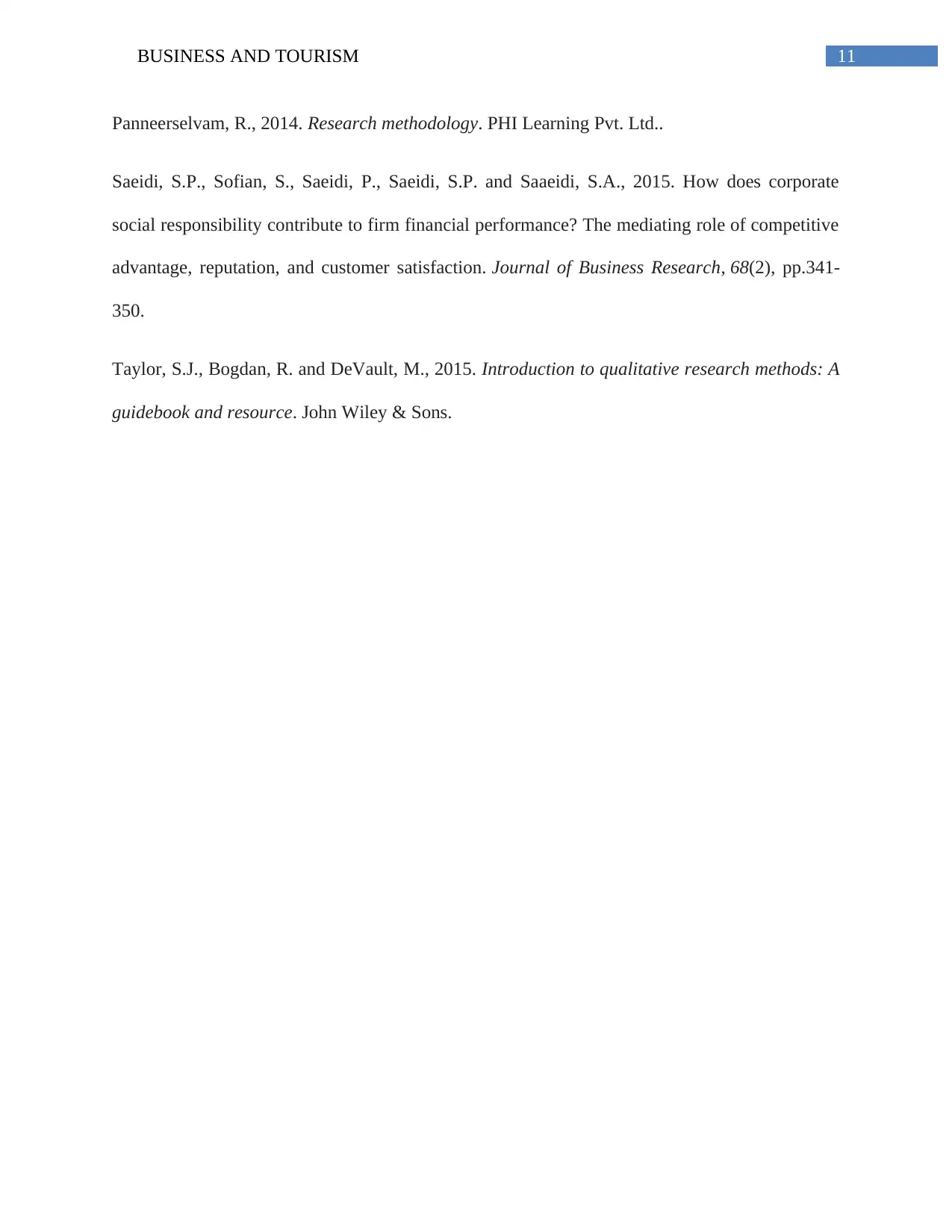
11BUSINESS AND TOURISM
Panneerselvam, R., 2014. Research methodology. PHI Learning Pvt. Ltd..
Saeidi, S.P., Sofian, S., Saeidi, P., Saeidi, S.P. and Saaeidi, S.A., 2015. How does corporate
social responsibility contribute to firm financial performance? The mediating role of competitive
advantage, reputation, and customer satisfaction. Journal of Business Research, 68(2), pp.341-
350.
Taylor, S.J., Bogdan, R. and DeVault, M., 2015. Introduction to qualitative research methods: A
guidebook and resource. John Wiley & Sons.
Panneerselvam, R., 2014. Research methodology. PHI Learning Pvt. Ltd..
Saeidi, S.P., Sofian, S., Saeidi, P., Saeidi, S.P. and Saaeidi, S.A., 2015. How does corporate
social responsibility contribute to firm financial performance? The mediating role of competitive
advantage, reputation, and customer satisfaction. Journal of Business Research, 68(2), pp.341-
350.
Taylor, S.J., Bogdan, R. and DeVault, M., 2015. Introduction to qualitative research methods: A
guidebook and resource. John Wiley & Sons.
⊘ This is a preview!⊘
Do you want full access?
Subscribe today to unlock all pages.

Trusted by 1+ million students worldwide
1 out of 12
Related Documents
Your All-in-One AI-Powered Toolkit for Academic Success.
+13062052269
info@desklib.com
Available 24*7 on WhatsApp / Email
![[object Object]](/_next/static/media/star-bottom.7253800d.svg)
Unlock your academic potential
Copyright © 2020–2025 A2Z Services. All Rights Reserved. Developed and managed by ZUCOL.





